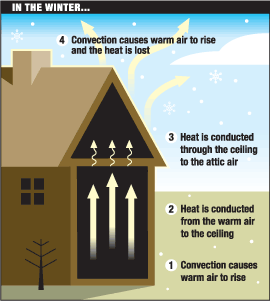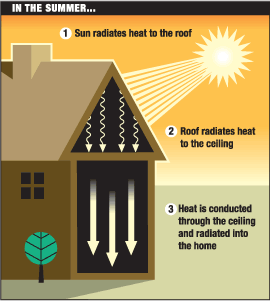The Truth About R- Values
 What’s an R-Value?
What’s an R-Value?
R-Value is the measure of the ability of insulation material to resist heat transfer. The R-Value is determined by placing carefully prepared test specimens between two plates in a laboratory apparatus and measuring heat flow through the insulation.
R-Value is a very accurate and reliable expression of how insulation materials perform with regard to conduction of energy in a laboratory apparatus. But people don’t live in laboratories or only deal with the conduction of energy. They live in homes with real walls and ceilings, and in the real world of buildings R-Value is only one factor which determines the actual performance of insulated building assemblies.
R-Value only tells part of the story..
R-Value is a laboratory  measurement that measures conduction, but it does not effectively measure the other two methods of heat transfer: convection and radiation. So R-Value is only telling 1/3 of the story of how well your home will be insulated in real world conditions.
measurement that measures conduction, but it does not effectively measure the other two methods of heat transfer: convection and radiation. So R-Value is only telling 1/3 of the story of how well your home will be insulated in real world conditions.
R-Value is important, but building scientists know that focusing on R-Value to the exclusion of all other factors can result in disappointment. It’s known, for instance, that thermal bridging can reduce the actual energy efficiency of a wall by up to 50 percent. U.S. scientists have proven that convective flows in very light density attic insulation can reduce its performance by more than 40 percent under winter conditions.
Cellulose insulation when applied at high density effectively resists air-infiltration. The Department of Energy (DOE) has written, “DON’T RELY ON THE INSULATION: The most common insulation, fiberglass, does not stop air leakage. In older homes, dirty fiberglass is a telltale sign of air movement (it simply collects dirt like a filter). Certain types of insulation such as dense-packed cellulose and certain foams, can be effective at reducing air flow as well as heat flow.” DOE Air Sealing Guide
The truth is…not all insulations effectively combat all three kinds of heat transfer.
Unlike other insulations, cellulose Insulation can effectively combats all three kinds of heat transfer. Insulation with an R-Value of up to 3.8 per inch, can be installed as a dense monolithic block in walls and as a blanket in the attic which significantly reduces air infiltration and acts as an effective barrier to heat transfer.
Whether your home was built a century ago or completed yesterday, it’s not too late for you to enjoy the benefits of Insulation. Covering old low-density loose-fill fiberglass in an attic with more of the same stuff “fails to restore the lost R-Value” that naturally occurs with fiberglass. But researchers at Oak Ridge found that when one “cap” loose-fill fiberglass with cellulose, it not only adds R-Value, it actually restores the effective R-Value that fiberglass loses during cold weather.
A study “Testing And Analysis Of The Comparative Performance of Cellulose Vs. Fiberglass Insulation” conducted by, “The state of Colorado Technical Energy Consultants for Homebuilders” reports; “…by conducting a controlled side-by-side test of fiberglass and cellulose insulation systems, this study indicates that the use of a properly installed cellulose Insulation system can significantly contribute to the reduction of air leakage in wall cavities and attics, thereby reducing the building heat loss and utility bills. It appears that the short fibers of the cellulose material, and the blown-in application, allow it to fill voids more effectively, while the higher density minimizes air movement. the average performance of all homes tested showed cellulose with a 25% to 35% reduction in infiltration when compared to fiberglass. The average impact to utility bills was a projected 12% to 14% reduction in space heating costs.” Many older homes were built with little or no insulation in the sidewalls. Your local installer can add Insulation to your existing home’s sidewalls, making your home more energy efficient — saving you money!
What R-Value should I have in my house?How much Insulation you should have in your home will vary based on what type of climate you live in, the construction of your home, what heating equipment you are using and what type of fuel your heating system uses. The U.S. Department of Energy has put together some recommendations for minimum R-Values based on where you live in the United States. For more information contact EcoKong at 480-788-7718 by email at info@ecokong.org or visit us at our website www.ecokong.org
